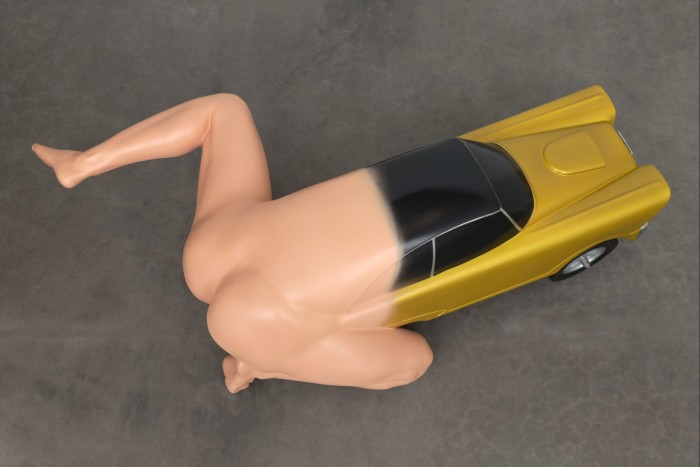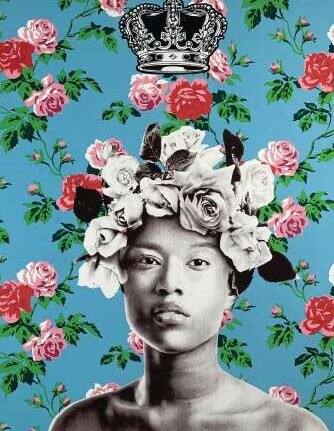Unlock the Editor’s Digest for free
Roula Khalaf, Editor of the FT, selects her favourite stories in this weekly newsletter.
The age-old promise of Los Angeles is that any dream can grow in its fertile climate — even one that seems like science fiction. For a century, the film and aerospace industries have made the unreal possible here. From mystics to movie stars, Pilates instructors to plastic surgeons, self-transformation is a civic article of faith. Lately, however, the city has more closely resembled dystopian films such as Blade Runner and Strange Days, a burning landscape choked with police drones, delivery robots and driverless cars. And with Hollywood stuck in a cycle of reboots, contemporary artists are producing the most novel visions of the future.
Visitors to the latest edition of Frieze LA will encounter a piece of bizarre technology. Part of the fair’s Focus section, Xin Liu’s “The Theater of Metamorphoses” is a structure housing a bronze cast of the artist’s mouth. It incorporates a refrigeration system commonly used to freeze human embryos. Seen up close, the frosted lips seem at once uncannily human and as if they belong to an entirely different species. Liu’s work speculates on the future entanglements of evolution and engineering.
For decades, before her death last December, artist and inventor Pippa Garner fantasised about the possibilities of becoming a cyborg. Many of her sculptures, such as the early half-human, half-hot rod “Kar-Mann” (1969), a central work in her recent solo exhibition at Hollywood’s Stars gallery, toy with the gendered conventions of auto-mania and other macho subcultures, while poking fun at American commodity fetishism. Garner regarded her own body as another technology to be tinkered with and her gender transition as the ultimate work of art — striking a chord with a younger generation interested in various forms of “bio-hacking”.

Garner was included in another recent show in LA, Post Human at Jeffrey Deitch gallery. The exhibition also featured younger sculptors whose figurative works were, in some cases, actual cyborgs. The hyper-realistic woman in Cajsa von Zeipel’s “Pep Talk” (2024) piloted a futuristic, lime-green-accented dune buggy with her robot handlebar arms. Ivana Bašić took a different approach to modelling the children of the future: her glass, wax and chrome creature emerging from a foetal cocoon resembled a friendlier version of HR Giger’s designs for Ridley Scott’s Alien.
Many younger artists are dreaming up new frontiers for humankind while acknowledging that the future could just as easily be a totalitarian nightmare. Old enough to remember a world without the internet, yet young enough that it has profoundly shaped their worldview, they treat technology not just as a threat but as a tool for good, if placed in the right hands.
A sweet, earthy scent fills the air in Scientia Sexualis, currently at LA’s Institute of Contemporary Art, where artist Candice Lin has installed a machine that emits vapour derived from herbs traditionally believed to induce abortions. With abortion access and transgender rights under attack by President Trump and his tech industry cronies, the exhibition places pseudoscientific attempts to regulate sex and gender under the magnifying glass.

A few works approach the topic with medical precision. Jes Fan’s “Form Begets Function” (2020) features glass balls injected with melanin and testosterone, which the artist has melted over what appears to be a mattress frame. Coated in white and fleshy-pink resin, the sculpture suggests that such bodily excretions should be a source of pride and pleasure, despite political attempts to control them.
Xandra Ibarra’s “Chest Rest” (2020) teases eroticism from materials associated with physical disability. A handrail curves around two folding tables that might serve in a surgery room, while atop them, footrests from wheelchairs have been affixed with pierced nipples, turning assistive devices into kinky props. The sculptures were inspired by the archives of Sheree Rose and Bob Flanagan, artist-partners whose BDSM performances sought to “fight sickness with sickness”, countering the pain of Flanagan’s cystic fibrosis with sexual pleasure.
Scientia Sexualis is part of Pacific Standard Time: Art and Science Collide, a biennial initiative sponsored by the Getty. One of more than 70 participating exhibitions across LA, it is not alone in its critical stance. All Watched Over By Machines of Loving Grace, on view at Redcat, strikes a somewhat optimistic note: its diverse group of artists employ machine learning to envision a more tolerant and sustainable world. Kira Xonorika’s “Deep Time Dance” (2024), an alluring, AI-animated pas de deux between an ancestral deity and a hummingbird, tells the origin story of two-spirit people, an indigenous North American third gender. Another monitor displays “Not the Only One (N’TOO)”, an AI-avatar that Stephanie Dinkins trained on data sets collected from three generations of Black women in her family. Countering the racist biases of much AI, “N’TOO” is a reminder that the technology channels the perspectives of its makers.

Beneath a towering bank of screens constructed by the Mexican artist collective Interspecifics, visitors are invited to place Petri dishes with live cultures beneath a digital microscope, which scans them and feeds them into an algorithm, producing new, virtual organisms. It’s an intriguing glimpse of art as evolutionary biology.
The exhibition takes its name from a 1967 poem by Richard Brautigan. “I like to think of a cybernetic meadow where mammals and computers live together in mutually programming harmony like pure water touching clear sky,” he wrote. Meadows are scarce in LA these days, and Brautigan’s dream seems like a distant horizon — but these artists insist that it’s still worth hoping for something better.
‘Scientia Sexualis’, to March 2, theicala.org; ‘All Watched Over By Machines of Loving Grace’, to February 23, redcat.org; Frieze LA, February 20-23, frieze.com
Find out about our latest stories first — follow FT Weekend on Instagram and X, and sign up to receive the FT Weekend newsletter every Saturday morning







